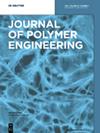Additive manufactured parts produced by selective laser sintering technology: porosity formation mechanisms
IF 1.7
4区 工程技术
Q4 POLYMER SCIENCE
引用次数: 2
Abstract
Abstract Additive manufacturing represents a powerful tool for the fabrication of parts with complex shapes by the deposition and the consolidation of materials as opposed to subtractive manufacturing methodology. Selective laser sintering (SLS), one of the most popular powder bed fusion (PBF) technologies for thermoplastic part production, has demonstrated extensive applications in various industrial sectors. The process involves the deposition of homogeneous powder layers and employs a laser source to selectively melt a powder bed according to a CAD model. Due to its layer-by-layer nature, voids and pores are inevitably introduced in the fabricated thermoplastic parts. Porosity represents one of the major limitations of this technology being one of the main causes of the variation of the mechanical properties. With the intention of providing support for reducing the porosity and thus increasing the quality and performance of the final product, in this paper, a brief review was carried out focusing on the SLS process parameters and their interaction with the porosity of the product. In addition, an in-depth look was given to the mechanisms of formation and consolidation of pores within parts made of polymeric material.选择性激光烧结技术生产的增材制造零件:孔隙形成机制
与减法制造方法相反,增材制造是一种强大的工具,可以通过沉积和材料巩固来制造具有复杂形状的零件。选择性激光烧结(SLS)是热塑性零件生产中最流行的粉末床熔融(PBF)技术之一,在各个工业领域都有广泛的应用。该工艺涉及均匀粉末层的沉积,并使用激光源根据CAD模型选择性地熔化粉末床。由于其逐层的性质,在制造的热塑性部件中不可避免地引入了空隙和孔隙。孔隙率是该技术的主要限制之一,也是导致机械性能变化的主要原因之一。为了为降低孔隙率从而提高最终产品的质量和性能提供支持,本文对SLS工艺参数及其与产品孔隙率的相互作用进行了简要综述。此外,深入研究了聚合物材料制成的零件中孔隙的形成和巩固机制。
本文章由计算机程序翻译,如有差异,请以英文原文为准。
求助全文
约1分钟内获得全文
求助全文
来源期刊

Journal of Polymer Engineering
工程技术-高分子科学
CiteScore
3.20
自引率
5.00%
发文量
95
审稿时长
2.5 months
期刊介绍:
Journal of Polymer Engineering publishes reviews, original basic and applied research contributions as well as recent technological developments in polymer engineering. Polymer engineering is a strongly interdisciplinary field and papers published by the journal may span areas such as polymer physics, polymer processing and engineering of polymer-based materials and their applications. The editors and the publisher are committed to high quality standards and rapid handling of the peer review and publication processes.
 求助内容:
求助内容: 应助结果提醒方式:
应助结果提醒方式:


